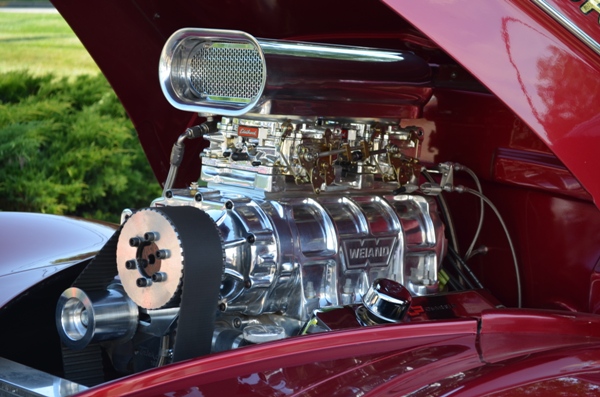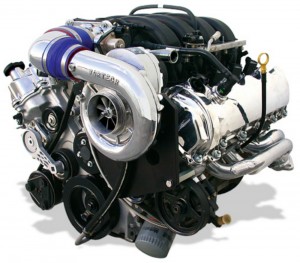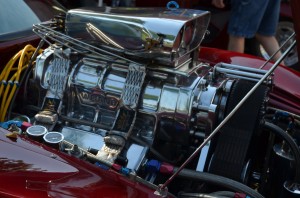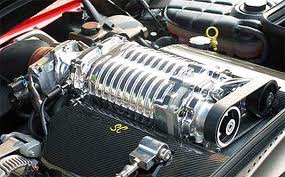
Many people have the impression that a supercharger is an exotic performance part found on wild street machines or race cars. There’s also the impression a supercharged vehicle is difficult to drive on an everyday basis. Nothing could be further from the truth on both counts.
Truth is, a supercharger is nothing more than a large air pump that can provide greater than atmospheric pressure (boost) to an engine.
When was the last time you thought of an air pump as exotic?
With help from the folks at Weiand and Holley, this three-part series will cover the relationship between compression ratio and boost level, and provide guidelines for choosing the right supercharger based on these factors. We’ll also offer recommendations for engine upgrades based on desired boost and horsepower levels. For now, we’ll start with an overview of superchargers, including blower styles and basic terminology.
Supercharging 101: How a Supercharger Works
To review, superchargers are simply air pumps that pack more air into your engine cylinders. As the superchargers compress and cram more air and fuel into the engine, the combustion charge becomes more potent, and the engine can produce more power and torque. For example, a street-driven vehicle running 6-7 pounds of boost will pack approximately 40-50 percent more air into its cylinders on the intake stroke compared to an unblown engine. This allows a smaller displacement engine produce similar horsepower and torque to a naturally-aspirated larger displacement engine.
Centrifugal vs. Roots vs. Screw-Type Superchargers
Supechargers typically utilize one of three designs: centrifugal, Roots, or screw-type.
 Centrifugal superchargers are similar to turbochargers in many ways. However, centrifugal superchargers are actually driven by a belt off the engine, while a turbocharger is exhaust driven. Centrifugal superchargers rely on an internal impeller to step up boost. Because boost depends on how fast the impeller spins, these units generally do not create as much boost at low rpms (turbo lag), because the impeller is not spinning fast enough. However, if your vehicle already produces good low-end power and torque, a centrifugal blower is the best choice for maximizing high-rpm power.
Centrifugal superchargers are similar to turbochargers in many ways. However, centrifugal superchargers are actually driven by a belt off the engine, while a turbocharger is exhaust driven. Centrifugal superchargers rely on an internal impeller to step up boost. Because boost depends on how fast the impeller spins, these units generally do not create as much boost at low rpms (turbo lag), because the impeller is not spinning fast enough. However, if your vehicle already produces good low-end power and torque, a centrifugal blower is the best choice for maximizing high-rpm power.
 Roots-type superchargers are simply large air pumps. A Roots-type blower pulls in air and compresses it in the engine’s cylinders. The speed at which the supercharger fills the cylinders depends on how quickly it is driven by a pulley and drive belt. The main drawback to Roots-style superchargers is the consistency of the air charge. While centrifugal superchargers provide smooth, continuous airflow, the Roots blowers feed air into the engine in lumpier, inconsistent bursts, thereby slightly reducing efficiency. However, Roots-type blowers produce a flatter torque curve with linear power across the rpm range, making it the ideal choice for adding throttle response and streetable low-end power. Roots-style superchargers are also generally less expensive than their centrifugal counterparts, but because of their inherent design, they are more likely to cause clearance issues with stock hoods.
Roots-type superchargers are simply large air pumps. A Roots-type blower pulls in air and compresses it in the engine’s cylinders. The speed at which the supercharger fills the cylinders depends on how quickly it is driven by a pulley and drive belt. The main drawback to Roots-style superchargers is the consistency of the air charge. While centrifugal superchargers provide smooth, continuous airflow, the Roots blowers feed air into the engine in lumpier, inconsistent bursts, thereby slightly reducing efficiency. However, Roots-type blowers produce a flatter torque curve with linear power across the rpm range, making it the ideal choice for adding throttle response and streetable low-end power. Roots-style superchargers are also generally less expensive than their centrifugal counterparts, but because of their inherent design, they are more likely to cause clearance issues with stock hoods.
 Screw-type superchargers are similar in appearance to Roots-type blowers, but they differ in one key way. Whereas Roots superchargers compress the inlet charge within the engine’s cylinders, screw-type superchargers use a set of interleaving internal rotors to draw in and compress air within the supercharger itself. Screw-type superchargers are typically the most expensive of the blower styles.
Screw-type superchargers are similar in appearance to Roots-type blowers, but they differ in one key way. Whereas Roots superchargers compress the inlet charge within the engine’s cylinders, screw-type superchargers use a set of interleaving internal rotors to draw in and compress air within the supercharger itself. Screw-type superchargers are typically the most expensive of the blower styles.
Boost Review
Boost is the amount of air pressure created by the supercharger and is mainly the function of three factors: engine displacement, blower displacement, and blower drive speed. Because higher boost means more power, many enthusiasts look for ways to bump up their boost levels.
You can increase boost by swapping out the existing supercharger pulley for a smaller pulley, which drives the supercharger faster. It is important to remember, though, that the amount of boost that you can safely run is limited by the compression ratio of your engine. Too much boost can lead to detonation, which can destroy your motor. In part two of our Blower Basics series, we’ll provide some valuable information on how your static compression ratio relates to safe boost levels.
Many supercharger manufacturers give their unit a boost range—a ballpark figure of the amount of boost you can expect using the standard pulley included with the supercharger. By making some engine modifications you can assure yourself that your boost level will land on the high end of this scale. We’ll share some upgrade tips in part three of this series.
Other Key Supercharger Terminology
- Volumetric efficiency: The efficiency and effectiveness with which an engine cylinder is filled with air; for example, if an engine cylinder filled completely with air on the intake stroke, it would have a volumetric efficiency of 100 percent. A supercharger packs engine cylinders with greater-than-100 percent volumetric efficiency.
- Static compression ratio: The compression ratio that is built into your naturally aspirated engine.
- Effective compression ratio: The approximate compression ratio when boost pressure is combined with static compression ratio. This is important in calculating safe boost levels for an engine—we’ll cover effective compression ratio more in Blower Basics (Part 2).
- Detonation: Spontaneous combustion of leftover air/fuel mixture in the engine cylinders, most likely due to increased heat and (boost) pressure. Detonation in forced induction can cause serious engine damage and should be avoided at all cost.
- Rotors and Impellers: Internal supercharger mechanisms within the supercharger that compress air. Rotors are found on Roots and screw-type superchargers; impellers are typically found on centrifugal blowers.
You can read Part 2, which covers what you need to know about boost, here.

[…] Supercharger: a crank driven air-to-fuel mixture compressor which increases atmospheric pressure on the engine, resulting in added horsepower. […]
[…] we told you in Blower Basics (Part 1), boost is the amount of air pressure created by your supercharger and is the result of a […]
[…] Blower Basics (Part 1), we debunked the myth that a supercharger is an exotic upgrade. We even gave you basic boost and […]
As an engineer.
I have a question… Seeing that one can ‘safely’ have as much as a 12:1 compression ratio with 92 octane in a boosted engine(based on the effective CR table above) – can one have as much effective CR on an NA engine – or will it not work\be safe? Thanks…
For higher compression engines, you’ll need to make some modifications. Please see the Blower Basics, Part 3 post for suggestions.
Just saw your website and I have been searching for an answer and I hope you can and will help me. I have a Detroit 8V-71 Bus with a blower on it and it was running but would not restart a short time later even with a quick shop of either. I can turn the blower shaft (with auxiliary drive hub off) and it turns the blower vanes. My question is if the spring pack is bad would this cause this problem and exactly what is the function/purpose of the spring pack…what does it do? Thanks.
John
what are common damage caused by detonation in a street blown engine
So a super charger and a blower is one in the same
How much horse power gainage does a supercharger, when installed.?
[…] Want to really get into the weeds on engine superchargers? Read this: Blower Basics (Part 1): A Guide to Supercharger Types & Terminology […]
What is th size difference between a 671 blower and an 870 series blower what does the 71in 671 refer to vice the 71 in 671 nd the 870 series blower
Hey thanks for reading–rather than reprise what they wrote, check out this article from Dragzine–it’ll answer your question.